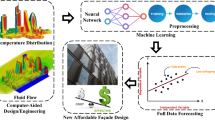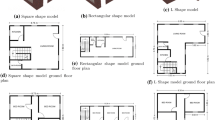Abstract
Mixed-mode ventilation can effectively reduce energy consumption in buildings, as well as improve thermal comfort and productivity of occupants. This study predicts thermal and energy performance of mixed-mode ventilation by integrating computational fluid dynamics (CFD) with energy simulation. In the simulation of change-over mixed-mode ventilation, it is critical to determine whether outdoor conditions are suitable for natural ventilation at each time step. This study uses CFD simulations to search for the outdoor temperature thresholds when natural ventilation alone is adequate for thermal comfort. The temperature thresholds for wind-driven natural ventilation are identified by a heat balance model, in which air change rate (ACH) is explicitly computed by CFD considering the influence of the surrounding buildings. In buoyancy-driven natural ventilation, the outdoor temperature thresholds are obtained directly from CFD-based parametric analysis. The integrated approach takes advantage of both the CFD algorithm and energy simulation while maintaining low levels of complexity, enabling building designers to utilize this method for early-stage decisionmaking. This paper first describes the workflow of the proposed integrated approach, followed by two case studies, which are presented using a three-floor office building in an urban context. The results are compared with those using an energy simulation program with built-in multizone modules for natural ventilation. Additionally, adaptive thermal comfort models are applied in these case studies, which shows the possibility of further reducing the electricity used for cooling.
Similar content being viewed by others
References
ASHRAE (2013a). ASHRAE Standard 55-2013. Thermal Environmental Conditions for Human Occupancy. Atlanta: American Society of Heating, Refrigerating and Air-Conditioning Engineers.
ASHRAE (2013b). ASHRAE Standard 62.1-2013. Ventilation for Acceptable Indoor Air Quality. Atlanta, American Society of Heating, Refrigerating and Air-Conditioning Engineers.
Asfour OS, Gadi MB (2007). A comparison between CFD and network models for predicting wind-driven ventilation in buildings. Building and Environment, 42: 4079–4085.
Atkinson J, Chartier Y, Pessoa-Silva C, Jensen P, Li Y, Seto WH (2009). Natural Ventilation for Infection Control in Health-care Settings—WHO Guidelines. Geneva: World Health Organization.
Bangalee MZI, Lin SY, Miau JJ (2012). Wind driven natural ventilation through multiple windows of a building: A computational approach. Energy and Buildings, 45: 317–325.
Beausoleil-Morrison I (2002). The adaptive conflation of computational fluid dynamics with whole-building thermal simulation. Energy and Buildings, 34: 857–8871.
Brager G, Borgeson S, Lee YS (2007). Summary Report: Control Strategies for Mixed-mode Buildings. Berkeley: Centre for the Built Environment, University of California.
Cândido C, de Dear R, Lamberts R, Bittencourt L (2008). Natural ventilation and thermal comfort: Air movement acceptability inside naturally ventilated buildings in Brazilian hot humid zone. In: Proceedings of Air Conditioning and the Low Carbon Cooling Challenge Conference, Windsor, UK.
Chen Q (2009). Ventilation performance prediction for buildings: A method overview and recent applications. Building and Environment, 44: 848–858.
Chen Q, Glicsman L, Lin J, Scott A (2007). Sustainable urban housing in China. Journal of Harbin Institute of Technology (New Series), 14s: 6–9.
CMU (2004). Guidelines for High Performance Buildings. NSF/IUCRC Center for Building Performance and Diagnostics at Carnegie Mellon University, Advanced Building Systems Integration Consortium.
de Dear RJ, Brager GS (1998). Developing an adaptive model of thermal comfort and preference. ASHRAE Transactions, 104(1): 145–167.
de Dear, RJ, Brager, GS (2002). Thermal comfort in naturally ventilated buildings: Revisions to ASHRAE Standard 55. Energy and Buildings, 34: 549–561.
DOE (2014). EnergyPlus engineering reference: The reference to EnergyPlus calculations. US Department of Energy.
Dutton S, Shao L (2010). Window opening behaviour in a naturally ventilated school. In: Proceedings of SimBuild, New York, USA, pp.260–268.
Evans M (1980). Housing, Climate and Comfort. New York: John Wiley and Sons.
Ezzeldin S, Rees SJ (2013). The potential for office buildings with mixed-mode ventilation and low energy cooling systems in arid climates. Energy and Buildings, 65: 368–381.
Gandhi P, Brager G, Dutton S (2014). Mixed mode simulation tools. Internal report, Center for the Built Environment (CBE).
Haw LC, Saadatian O, Sulaiman MY, Mat S, Sopian K (2012). Empirical study of a wind-induced natural ventilation tower under hot and humid climatic conditions. Energy and Buildings, 52: 28–38.
Jiang Y, Chen Q (2003). Buoyancy-driven single-sided natural ventilation in buildings with large openings. International Journal of Heat and Mass Transfer, 46: 973–988.
Khan N, Su Y, Riffat SB (2008). A review on wind driven ventilation techniques. Energy and Buildings, 40: 1586–1604.
Launder BE, Spalding DB (1974). The numerical computation of turbulent flows. Computer Methods in Applied Mechanics and Engineering, 3: 269–289.
Liu PC, Lin HT, Chou JH (2009). Evaluation of buoyancy-driven ventilation in atrium buildings using computational fluid dynamics and reduced-scale air model. Building and Environment, 44: 1970–1979.
Manz H, Frank T (2005). Thermal simulation of buildings with double-skin facades. Energy and Buildings, 37: 1114–1121.
Mentor Graphics (2014). FloVENT. Available at http://www.mentor.com/products/mechanical/flovent. Accessed 31 Jul 2014.
MI Research (2014). FlowDesigner. Available at http://www.mi-research. com/MI_Research/FlowDesigner.html. Accessed 31 Jul 2014.
Neofytou P, Venetsanos AG, Vlachogiannis D, Bartzis JG, Scaperdas A (2006). CFD simulations of the wind environment around an airport terminal building. Environmental Modelling & Software, 21: 520–524.
Pappas A, Zhai Z (2008). Numerical investigation on thermal performance and correlations of double skin facade with buoyancydriven airflow. Energy and Buildings, 40: 466–475.
Rijal HB, Tuohy P, Humphreys MA, Nicol JF, Samuel A, Clarke J (2007). Using results from field surveys to predict the effect of open windows on thermal comfort and energy use in buildings. Energy and Buildings, 39: 823–836.
Robert McNeel & Associates (2015). Rhinoceros. Available at https:// www.rhino3d.com. Accessed 22 Jun 2015
Shen X, Zhang G, Bjerg B (2012). Comparison of different methods for estimating ventilation rates through wind driven ventilated buildings. Energy and Buildings, 54: 297–306.
Sherman MH (1990). Tracer-gas techniques for measuring ventilation in a single zone. Building and Environment, 25: 365–374.
Sherman MH, Walker IS, Lunden MM (2014). Uncertainties in air exchange using continuous-injection, long-term sampling tracer-gas methods. International Journal of Ventilation, 13: 13–27.
Tan G, Glicksman L (2005). Application of integrating multi-zone model with CFD simulation to natural ventilation prediction. Energy and Buildings, 37: 1049–1057.
Tong Z, Wang YJ, Patel M, Kinney P, Chrillrud S, Zhang KM (2012). Modeling spatial variations of black carbon particles in an urban highway-building environment. Environmental Science & Technology, 46: 312–319.
Tong Z, Zhang KM (2015). The near-source impacts of diesel backup generators in urban environments. Atmospheric Environment, 109: 262–271.
Wang L, Chen Q (2005). On solution characteristics of coupling of multizone and CFD programs in building air distribution simulation. In: Proceedings of 9th International IBPSA Building Simulation Conference, Montreal, Canada.
Wang L, Chen Q (2007). Theoretical and numerical studies of coupling multizone and CFD models for building air distribution simulations. Indoor Air, 17: 348–361.
Wang L, Chen Q (2008). Evaluation of some assumptions used in multizone airflow network models. Building and Environment, 43: 1671–1677.
Wang L, Wong NH (2007). The impacts of ventilation strategies and facade on indoor thermal environment for naturally ventilated residential buildings in Singapore. Building and Environment, 42: 4006–4015.
Wang L, Wong NH (2008). Coupled simulations for naturally ventilated residential buildings. Automation in Construction, 17: 386–398.
Wang L, Wong NH (2009). Coupled simulations for naturally ventilated rooms between building simulation (BS) and computational fluid dynamics (CFD) for better prediction of indoor thermal environment. Building and Environment, 44: 95–112.
Wang YJ, Nguyen MT, Steffens JT, Tong Z, Wang Y, Hopke PK, Zhang KM (2013). Modeling multi-scale aerosol dynamics and microenvironmental air quality near a large highway intersection using the CTAG model. Science of the Total Environment, 443: 375–386.
Xie Z, Castro IP (2006). LES and RANS for turbulent flow over arrays of wall-mounted obstacles. Flow, Turbulence and Combustion, 76: 291–312.
Yi YK, Feng N (2013). Dynamic integration between building energy simulation (BES) and computational fluid dynamics (CFD) simulation for building exterior surface. Building Simulation, 6: 297–308.
Zhai ZJ, Chen QY (2005). Performance of coupled building energy and CFD simulations. Energy and Buildings, 37: 333–344.
Zhang R, Lam KP, Yao SC, Zhang Y (2013). Coupled EnergyPlus and computational fluid dynamics simulation for natural ventilation. Building and Environment, 68: 100–113.
Author information
Authors and Affiliations
Corresponding author
Electronic supplementary material
Rights and permissions
About this article
Cite this article
Malkawi, A., Yan, B., Chen, Y. et al. Predicting thermal and energy performance of mixed-mode ventilation using an integrated simulation approach. Build. Simul. 9, 335–346 (2016). https://doi.org/10.1007/s12273-016-0271-x
Received:
Revised:
Accepted:
Published:
Issue Date:
DOI: https://doi.org/10.1007/s12273-016-0271-x




